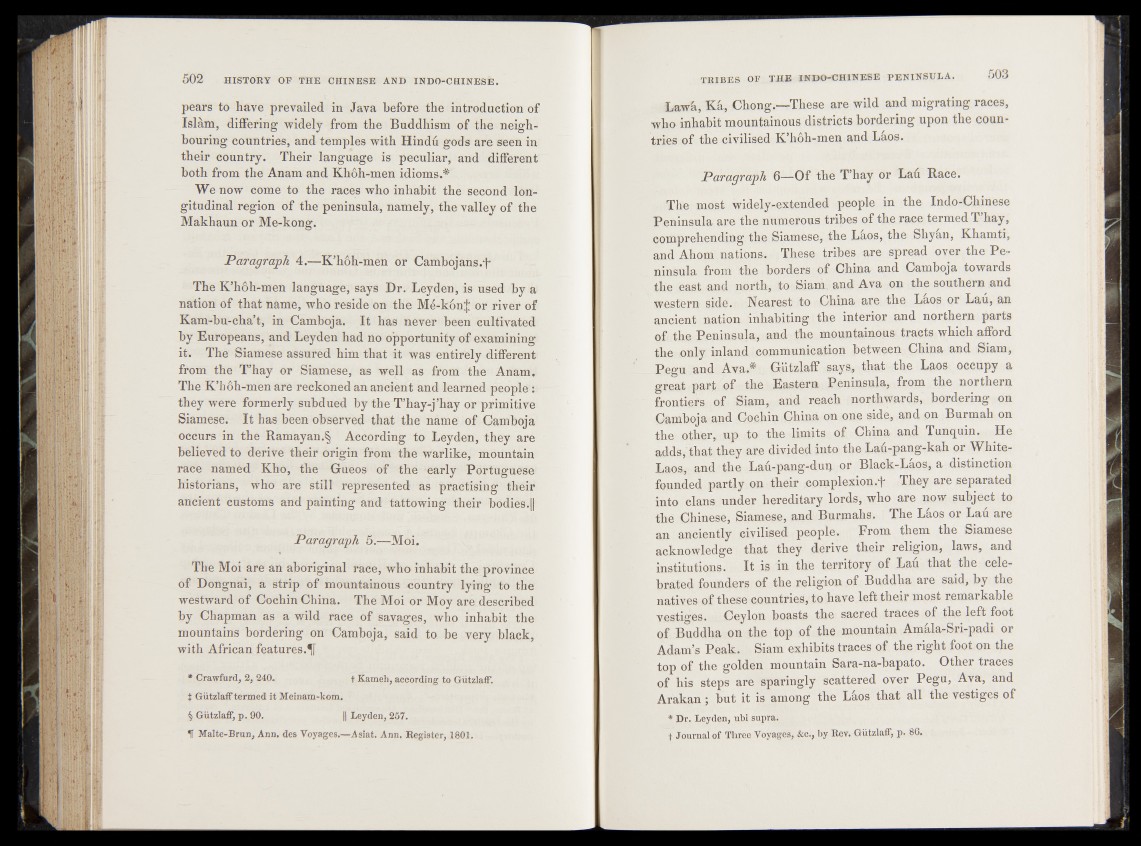
pears to have prevailed in Java before the introduction of
Islam, differing widely from the Buddhism of the neighbouring
countries, and temples with Hindk gods are seen in
their country. Their language is peculiar, and different
both from the Anam and Khôh-men idioms.*
We now come to the races who inhabit the second longitudinal
region of the peninsula, namely, the valley of the
Makhaunor Me-kong.
Paragraph 4.4-K.5hôh-men or Cambojans.J*
The K’hôh-men language, says Dr. Leyden, is used by a
nation of that name, who reside-on the Mé-kónJ or river of
Kam-bu-cha’t, in Camboja. It has never been cultivated
by Europeans, and Leyden had no opportunity of examining
it. The Siamese assured him that it was entirely different«
from the T’hay or Siamese, as well as from the Anam.
The K’hôh-men are reckoned an ancient and learned people :
they were formerly subdued by the T’hay-j’hay or primitive
Siamese. It has been observed that the name of Camboja
occurs in the Ramayan.§ According to Leyden, they are
believed to derive their origin from the warlike, mountain
race named Kho, the Gueos of the -early' ^Portuguese“
historians, who are still represented as practising their
ancient customs and painting and tattowing their bodies.!;
Paragraph 6.—Moi.
The Moi are an aboriginal race, who inhabit the province
of Dongnai, a strip of mountainous country lying to the
westward of Cochin China. The Moi or Moy are described
by Chapman as a wild race of savages, who inhabit the
mountains bordering on Camboja, said to be very black,
with African features.
* Crawfurd, 2, 240. Kameh, according to Giitzlaff.
t Giitzlaff termed it Meinam-kom.
| Giitzlaff, p. 90. j| Leyden, 257.
I Malte-Brun, Ann. des Voyages.—Asiat. Ann. Register, 1801.
Lawk, Kk, Chong.-rThese are wild and migrating races,
who inhabit mountainous districts bordering upon the countries
tjbe civilised K’hêb-men and Laos.
Paragraph 6—Of the T’hay ôr Laû Race.
.. The most widelynexterided people in the Indo-Chinese
Peninsula are thepîimerous tribes of the race termed T’hay,
comprehending the Siaipèseÿ the Lkos, the Shyan, Khamti,
and Ahom nation^'Pt.esp tribes are spread over.the Pe?
ninsula from the borders of China and Camboja towards
the east and north, to Siam-, and Ava on ;the southern and
western side.- Nearest to China a r e , L a o s or Lau, an
ancient-nation inhabiting the interior and northern parts
of/ the Peninsula, and the mountainous tracts which afford
the onlÿ; inland communication between China and Siam,
-Pegu and Ava * putzlaff says* that -,the Laos occupy a
great parfc4f-the Eastern Peninsula, .from the northern
frontiers; of Siam, „add reach northwards,' bordering ^on
Camboja and Cochin;Çhina on one side, and pn Burmah on
the other,,,up to the limits of, China and Tunquin. He
adds, that they are divided into the Lau-pang-kah or White-
Laos, and ' the Lak-pang-dun or Black-rL#OSt a distinction
founded partly on their complexion.t They are separated
into clans under hereditary lords, who are now subject to
the Chinese, Siamese, and Burmahs. The Lkos Or Lau are
an anciently civilised people. From them the Siamese
acknowledge that they derive their religion, laws, and
institutions. It is in the territory o f Lan that the celebrated
founders of the religion of Buddha are said» by the
natives of these countries,do have leftfhdf most remarkable
vestiges. Ceylon boasts the sacred traces of the left foot
qf Buddha on the top of the mountain sAmhlatSri-padi or
Adam’s Peak. /Siam exhibits traces of the.rigbt foot.on the
top of the golden mountain Sara-na-bapato. Other traces
of his steps are sparingly scattered over Pegu, Ava, and
Arakan ; but it is among the Lkos that all the vestiges of
* Dr. Leyden, ubi supra.
"t Journal of Three Voyages, &c., by Rev. Giitzlaff, p. 86.